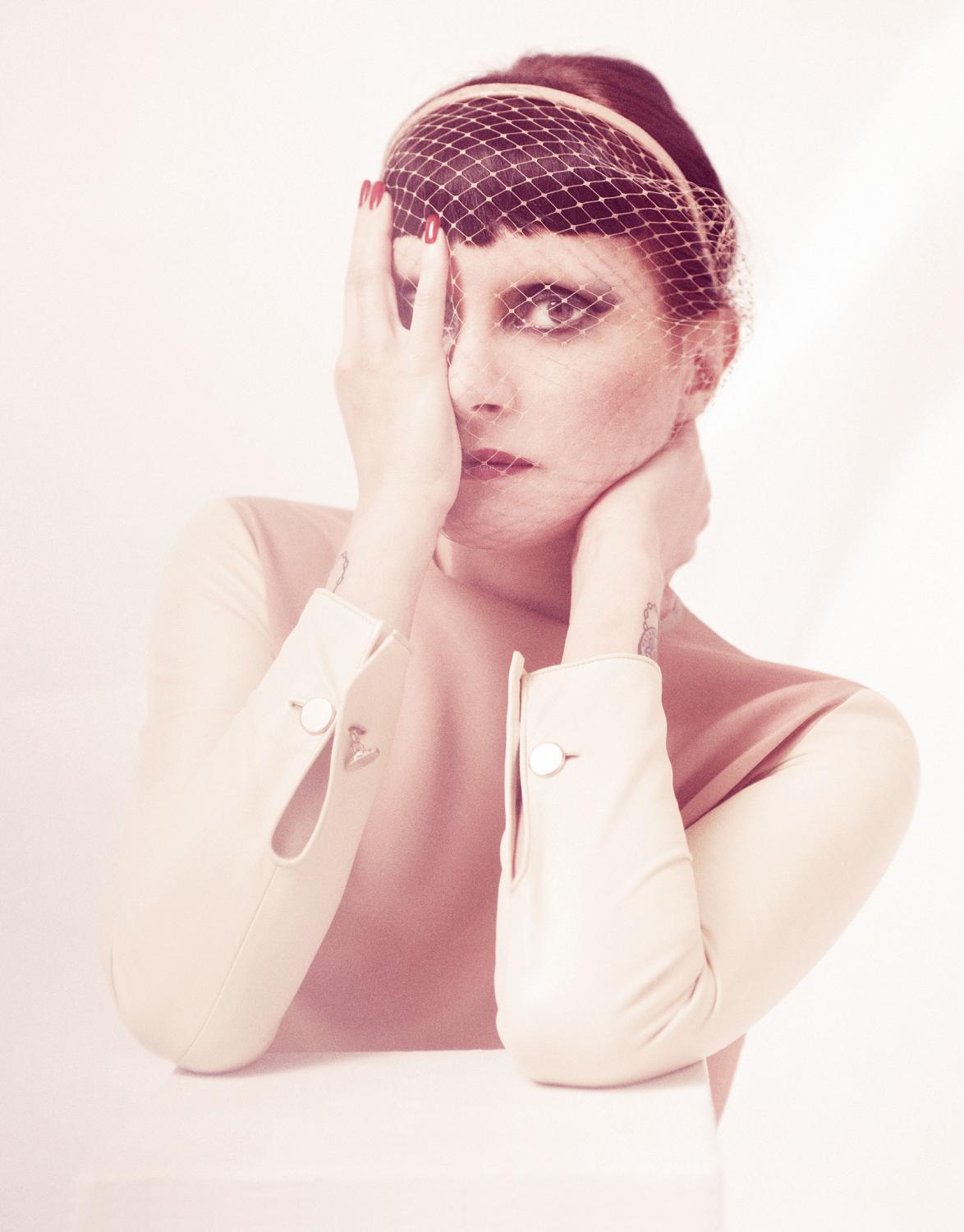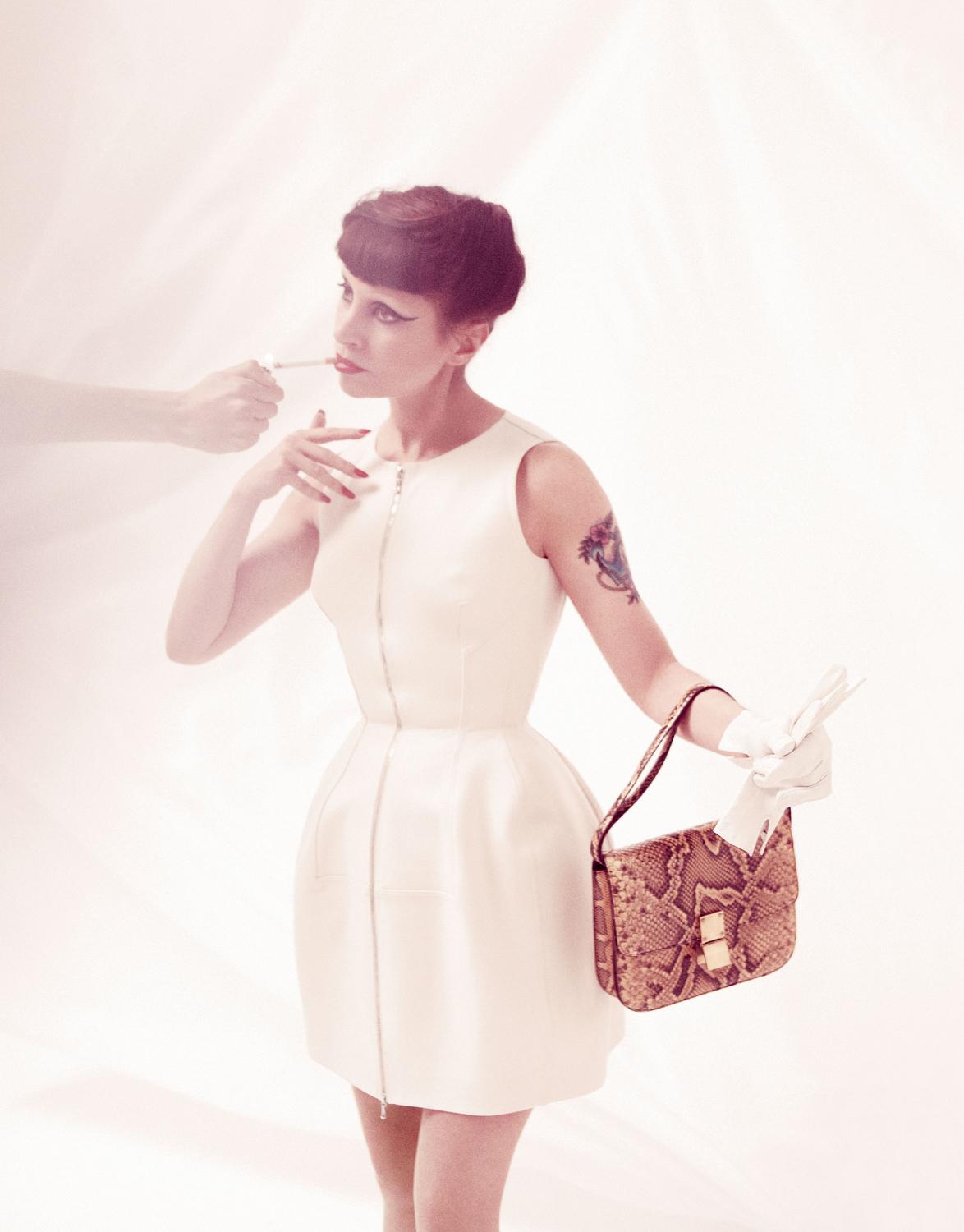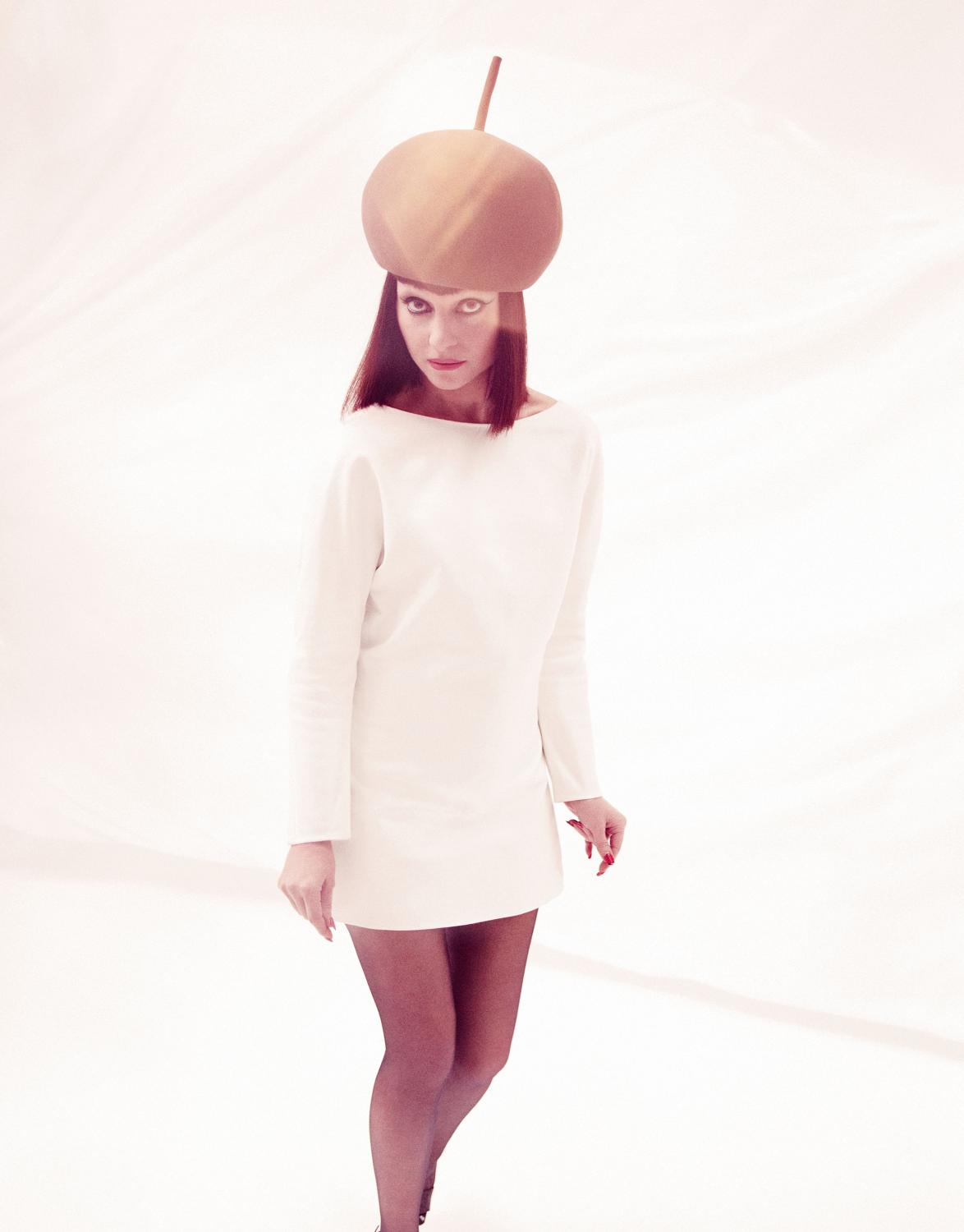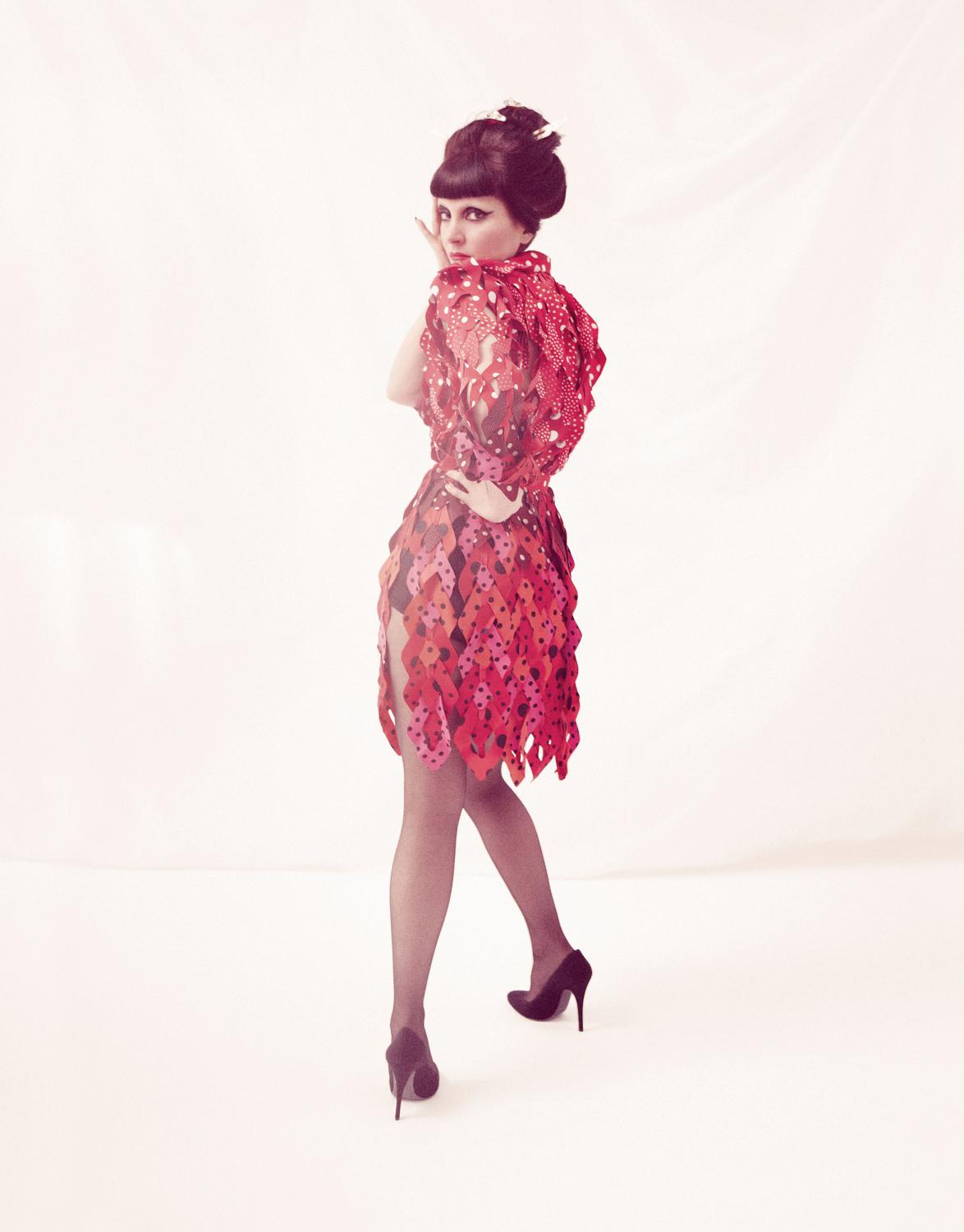Princess Julia
She’s been out every night for the past 34 years

Portraits by Benjamin Alexander Huseby
Styling by Jodie Barnes
Issue n° 1, Spring & Summer 2010
The beloved mother of London’s underground, Princess Julia has moved seamlessly through every important scene since punk, witnessing every high and low. Julia is a DJ of a rather uplifting nature who knows just how to entertain a dance floor with her fun, unselfconscious sets. She is also the co-editor of her own music fanzine, The P.i.X, an innovative monthly freesheet that folds out into a poster. But Julia’s role in the demimonde is much broader than all this. Fantastically good company, she constantly encourages and nurtures those who wish to follow her very individual example, maintaining a curiosity for new talent and for those who aspire to be something other than the norm.
Julia is an extraordinary raconteur who knows how to wield a loaded pause to devastating effect, and she has recently taken to the stage and started spoken-word performances. In fact, her life story is so hysterical that there is talk of it being made into a musical. A classic of her own design, Julia is never seen without a fully made-up face.
My first memory of Princess Julia is at a Buzzcocks gig at the Lyceum on the Strand, maybe late ’77 or early ’78. I was standing with Tracie O’Keefe and Debbie Wilson from Seditionaries when Julia walked past. The notoriously scrappy Tracie aimed a kick at her arse. I figured it was something to do with London’s punk hierarchy. The Seditionaries girls were queen bees, Julia was an arriviste.
Or maybe not. Turns out she was best friends with Kiki, who was going out with Paul Cook, the Sex Pistols’ drummer. Anyway, Julia clearly irritated Tracie, so she stood out for that. And for her brunette voluptuousness, not spiky or punky at all. She would have been 17 or 18. A couple of years later, she was on 19 magazine’s Christmas cover and, as the girl in Visage’s “Fade to Grey” video, she offered a vampishly exotic alternative to all-English pop tarts like Toyah Wilcox and the Human League’s Joanne and Susanne. By then, Julia had herself ascended to queen-bee status on the London scene. And, more than three decades later, she is still all of that.
Julia has been DJing since the early ’80s, and today she speaks with the droll, affectless drawl that I always imagine as the voice of London clubland, for downwardly mobile toffs as much as upwardly mobile cockneys (and aspiring immigrants like Leigh Bowery). Julia met them all, from the great and the good to the grubbiest guttersnipe. “And everyone’s a DJ now, which I quite like,” she says with a throaty chuckle. “It’s just putting on records, isn’t it really?”
Her DJing has taken her around the world, but she is most at home every other Thursday at a pub called the George & Dragon in East London. For the past three years, Julia has informed the scene with The P.i.X, a monthly free fanzine she edits with her friend Hanna Hanra and which supports bands they love regardless of any popular appeal. Then there’s “whatever else comes along”. Lately, she’s taken to performing, after the photographer Wolfgang Tillmans cajoled her into getting up at his annual end-of-summer party last year. Accompanied by Andrew, the drummer from O Children, she did a monologue.

Here, she wears a felt zip-front dress by ALAÏA, sheer nude tights by ARISTOC and white leather gloves by SERMONETA. Julia is always seen with both a handbag and a cigarette, and here her bag is CÉLINE and the cigarette is a MARLBORO LIGHT. In the opneing image, she wears a nude silk dress with cream leather sleeves by CÉLINE. Her nude voilette headband is by JENNIFER BEHR.
“I’d like to record some of the spoken-word stuff,” she says. “Not like I’ve got to get a deal or anything. I’m not going to be in the machinery of the record industry in that way. I think this project is a bit niche. But I love doing it. I’m a show-off.” She’s working with one of the girls from the band An Experiment On A Bird In The Air Pump and a guy called Dee. “We do loosely structured things, but it’s still quite spontaneous.”
Dee has taken Julia’s last name as his own. She claims: “He’s at the stage in his life when he’s reinvented himself.” And I imagine that, as a past mistress of reinvention, Julia often has that effect on young people, especially when she says things like, “Are we all products of our own imaginations, or somebody else’s?” There is a distinct difference between Princess Julia, nightlife stalwart, and Julia Fodor, shy girl with the nagging sense that she wasn’t good enough for much. Like hundreds of kids who came before and after, she created a persona that enabled her life. “A rite of passage”, she calls it. “Hiding behind make-up became a lifestyle choice for me.” (And hair-dye too. The dark brown colour she has now was apparently once her real colour.) “I get quite bored with my image, waking up every day with the same old face. So I’ll do something different. It’s quite subtle, though if you didn’t see me for a year, I’d look different.” Julia likes fashion, but concedes it’s not really her world. Her style icons are camp old biddies like Princess Diana’s stepmother Raine Spencer (“it’s something about that helmet hair”) and Joan Collins. “I like the idea that Joan is always dressed, no matter what. I definitely have this idea I will not go out of the house without lipstick at least. It’s not artificial: it’s more about taking care of yourself, having respect for yourself, keeping this idea up just for yourself. You could walk down the road and not meet anyone…but there’s always the off chance.”
For our lunch, Julia is most definitely dressed, in a bottle-green velvet shift, with a vintage lace blouse and high-laced, stiletto boots. “Power ballad boots. Like Heart,” is her perfect description. The whole package is swathed in a black astrakhan coat and fragranced with Guerlain. The impression is very MittelEuropa, in keeping with the Hungarian blood that flows through her veins. Even her tattoos – the delicate key on one hand, the flowery heart on the other – have a romantic Mayerling flavour. Does one unlock the other? “Maybe it does,” she murmurs.
Julia has always been drawn to people who mess around with their image. She herself started at a tender age. “For my eighth birthday, I wanted my ears pierced, a pair of hot pants, a smock top, corduroy trousers, and tights with patterns up the side.” She got the lot.
Julia brings up Woman in a Dressing Gown, a now-forgotten kitchen-sink drama classic with Yvonne Mitchell making a supreme effort at the beauty parlour only to have her well-laid plans to please her man crumble away in a thunderstorm. “I like the crumblingness,” says Julia. “You’re allowed to crumble. Drinking is a great anaesthetic, up to a point. I always say the answers are in the bottom of a bottle. In the greater scheme of things, you should be sad. I don’t understand the whole idea of trying to maintain a level of happiness all the time. I think things should have dips and highs. You need benchmarks.”

Julia sports an oversized beret by PIERRE CARDIN with a white cotton tunic by YVES SAINT LAURENT, ARISTOC sheer black tights and PIERRE HARDY black patent slingbacks.
Julia used to surrender to a good old wallow in depression. It was her “luxury item”, she says. In fact, she could get suicidal “over all the normal things – heartbreak, self-doubt, money worries, what other people thought.” Her depressions are now a thing of the past. She insists she misses them, though she also says, “I have the most splendid time. I think because I don’t expect it, everything just blows me away, small details of things I find really fascinating and exciting and inspiring. I meet people around me who do well and I think that’s fantastic.”
That generosity of spirit is one of Julia’s standout qualities. In the course of our conversation, she name-checks a number of current people she admires, and bigs up their projects, like Luis Venegas’s Candy magazine and Joe Daniel’s Angular Records. An actor friend wheels by our table with a baby in a pram. “What, you mean you’ve got a baby?” she wheedles. “Not a real baby? I love it that people are having babies.” There was a moment at the age of 28 that she describes as “weird” when she wanted one of her own, but it passed. Even though she claims she is passionate in her own funny way, she concedes she’s not a very cuddly person. And she’s never been much good at relationships. “I didn’t have a proper boyfriend till I was 30, I just couldn’t be bothered. I think it was all to do with self-worth.” And a whole lot of attempted conditioning at school, where the more she was steered towards housewifery and breeding, the more she shied away from them. Shy girl that she was, the imposition of such a conventional ethos activated a quiet rebellious streak. “I was always an independent thinker,” she says now. “I made my own mind up about things.”
It started in Hackney Hospital, since torn down, where Julia was born in 1960. Her father, Laszlo Fodor, arrived in England in 1958 as a Hungarian refugee. His educational qualifications weren’t recognised, so he spent most of his working life in the metal box factory on Cambridge Heath Road, adequate grounds for enduring bitterness. “I was told every day I was ugly and wasn’t going to amount to anything,” she says. “It’s part of me, like your history is part of you.” As a conservative Eastern European, the future that Laszlo envisaged for his eldest child was marriage and family. But if her father was Hungarian and her mother from Surrey, Julia herself is purest East End. Laszlo was husband hunting on Julia’s behalf from the time she turned 15, so he wasn’t best pleased when she began directing her energy to clubbing. “My parents didn’t understand it at all,” she remembers. “My father thought a nightclub was a clip joint with gangsters and guns.” And he never changed his mind on that point. In his 70s, when he was dying, he wanted to kill himself, and he was convinced Julia’s familiarity with clubland would give her easy access to a gun.

Julia is in a red polka-dot handkerchief dress from MAISON MARTIN MARGIELA’s artisanal collection with black ARISTOC tights and black knickers from AGENT PROVOCATEUR. The black pumps are GIUSEPPE ZANOTTI for BALMAIN.
School was something she endured; style was something she embraced. The Miss Mouse concession at Topshop was her bolthole. Her parents took in lodgers, including a girl student that Julia was allowed out with. They’d go clubbing in the Tottenham district of North London. As soon as she left school, she was looking for work in the West End. Make-up artiste appealed, but there wasn’t much going for a 16-year-old kid with no prior training. So she ended up at Crimpers, a hair salon in Knightsbridge. That’s where she met the aforementioned Kiki, her entrée into the punk world. “Yeah, I wore bondage pants, but glam, with heels. We’d save our pocket money and go down to Seditionaries: £50 for bondage pants, which was a lot when you were making £12.50 a week.”
The decade that followed punk – the febrile underworld of Earl’s Court, the Warren Street and Great Titchfield Street squats with Boy George, Stephen Jones and a host of other stars-to-be, the club nights at Blitz and Taboo, the generally outlandish hedonism – was the foundation of a lot of other people’s legends. Julia is not averse to reflecting on her own. “I like things in retrospect,” she says. “I like seeing those things with younger people as well, because they make a whole other thing of it. Things that I thought were a bit embarrassing are actually quite good.”
London has always been at the centre of her life. The city was the subject of the monologue she performed at Wolfgang’s party. “It was about the decay and the rebuilding of London, and I combined it a bit with the inspiration of Wolfgang’s work – crumbling walls, the flux of change. It was my own feeling about the obliteration of some buildings. They’re only walls, but humans get attached to walls.” The obliteration that’s been uppermost in her mind is the razing of the Astoria, the former music hall at the corner of Oxford Street and Tottenham Court Road, where a key station for the new Crossrail route is being built. “History is being destroyed,” Julia muses. “That was about four clubs just gone, and I’m affiliated with clubs. Change is good, but sometimes I wonder.”
“I’m not stuck in the past,” she adds. “You can cling onto those memories but they are just memories. Still, I enjoy that history and the history of other people as well, even the beginning of the world. Even though I’m not very scientifically minded, scientific things really appeal to me. I think I was always like that.” She’s been compelled to reflect on her own history because a while ago she was approached about turning her story into a stage musical. There was talk that Denise van Outen might play her. So she started making notes. “I’ve been in a nightclub since 1976…” was how she started. She went on to organise her bio by song, from Iggy Pop’s “Nightclubbing” to Dolly Parton’s “Here You Come Again”, Dionne Warwick to Divine, and everything in between; the soundtrack to a life lived long and fully.
Julia began DJing in the early ’80s, just putting records on for a laugh at a night Stephen Linnard was doing at the Wag Club. In those days, it was all about the disco divas – Amanda, Donna, Grace – and the tracks. People were mixing, but it was mostly about playing one side of a 12", flipping it for Part II. “Then, when bedroom technology came in, everything was geared up to beat-matching, with turntables and what have you. I went and watched people DJing that I thought were good at mixing, and I practised and practised and cried a lot.”
She counts the Daisy Chain, a late-’80s Tuesday nighter at The Fridge in Brixton, as her first official DJing position. “I was the warm-up for Jeffrey Hinton, then Jimmy Fox took me on and I ended up DJing for a sort of career. It was kind of by accident but it suited me well, in a sense. I’d done most jobs in a nightclub, and being a DJ enabled me to travel, which I wouldn’t have been able to do so much under my own steam. And the ’90s were a boom time for travelling DJs. I was quite happy to go around.”
“Well, everything’s a look, isn’t it? It’s all drag.”
She hated her family name when she was growing up because she wanted an English name. The “Princess” comes from the late ’80s, when she was DJing at the Daisy Chain. “Everyone had a jazzy DJ name, so Mark Lawrence, Jeffrey Hinton and I thought we should have one too. Mark’s name was Fancy Pants something, I think I called myself Lady Princess whatever whatever.”
There weren’t many women on the DJ scene: Smokin’ Jo, Rachel Auburn, Julia. It really was a boys’ club, and even more so in some of the other countries she played in. It’s easy to imagine some snide macho type finding it hard to take her seriously when she showed up in one of her looks (“Well, everything’s a look, isn’t it? It’s all drag”), but she was determined to be as professional as possible. She had an agent, she made money, and then she didn’t. Ups and downs.
It’s a cultural cliché that nightclubs have functioned as a crucible of contemporary creativity. But, hey, a cliché is only a cliché because it’s the truth. It certainly was for Julia, anyway. “The exciting thing about having a life in clubs was the variety of people you never thought you’d meet. With clubs, it was the idea of a scene that was full of misfits, deranged people escaping from reality, myself included. They were unsettled, misunderstood people, with nothing to lose. But they had a degree of artistic integrity, a sort of vision.”
I’m sure she’d be the first to admit it wasn’t exactly a utopian vision, given the human flotsam that bobbed to the surface and then plunged to the depths. Neither is it appropriate to recast her as the heroine in an idiosyncratically feminist version of Orpheus in the Underworld. Much more apt is Julia’s own description of herself as “someone on a quest for different ways to look at the same old things.” In that spirit of humble exploration, she insists she doesn’t mind going back over old ground, as long as she learns something new. She also says the best thing she’s ever been called was “a fragile rock”.
“Oooo, I just remembered that,” she adds, well chuffed. “Rupert Everett called me that. It could be a chapter in my book.”
I can’t wait.
Tim BlanksGregarious New Zealander Tim Blanks is a fantastic fashion writer who regularly contributes to publications such as Fantastic Man, Vogue, the Financial Times, Interview and GQ. Recognised for his extensive collection of fanciful shirts, he is editor at large for style.com, for which each fashion season…read more Portraits by
Benjamin Alexander HusebyThe photographer Benjamin Alexander Huseby hails from Norway. He studied at the Chelsea of School of Art, London and currently lives in Berlin. Benjamin is a contributor to magazines such as Fantastic Man, Self-Service, both UK and US editions of Vogue, BUTT, Dazed and i-D and his work has featured in…read more Styling by
Jodie BarnesJodie Barnes is fashion director of Fantastic Man, The Gentlewoman’s brother publication. With a reputation as one of the most indefatigable stylists in the fashion industry, Jodie’s precise eye and styling rigor has been deployed for many brands such as Adidas, Berluti, Chalayan, Closed, Hackett,…read more
Hair: Rudi Lewis. Make-up: Petros Petrohilos. Set design: Emma Roach, Tina Reisinger. Photographic assistance: Ramus Jensen. Styling assistance: Joe Porritt, Max Clark. Hair assistance: Anna Wongwattanarat. Digital operation: Devin Blair.
This profile was originally published in The Gentlewoman n° 1, Spring & Summer 2010.